Archive for the ‘Biofeedback’ Category
Wednesday, November 12th, 2014
by Siegfried Othmer, PhD
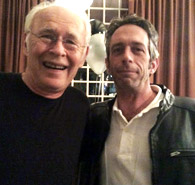
G eorge Fuller von Bozzay spoke about new developments in the area of wearables, apps, and other consumer-oriented devices. As it happens, he has himself been involved in one of these developments in the past. One of his neighbors is (or was) Ryan Gordon of Atari fame, and at a time when he was looking for projects he became intrigued with George Fuller’s idea for the development of video feedback for a GSR signal. Gordon insisted, however, that it be in the form of a game, and thus emerged the first such product, “Mind Drive.”
(more…)
Posted in Biofeedback, Conferences, Professional Issues | 2 Comments »
Tuesday, November 11th, 2014
by Siegfried Othmer, PhD
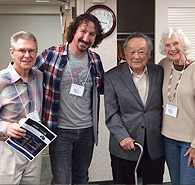
T he 40th Anniversary Celebration of the Biofeedback Society of California was an upbeat and rollicking affair. It got underway with a look back at the work of the Menninger group and the Life Sciences Institute by Patricia Norris. Ostensibly the key research objective there had been to study the dimensions of human consciousness, but in fact there was considerable engagement with the use of biofeedback for therapeutic purposes as well. The work with prisoners extended over nine years, and it reached a number of prisons. Support for this work was withdrawn at a time when the State of Kansas was facing a budgetary crisis that caused the cancellation of nearly all rehabilitation programs in the prisons, with the exception of some attention to violent sexual offenders.
(more…)
Posted in Biofeedback, Conferences, Neurofeedback, Research, Scientific | 2 Comments »
Wednesday, March 12th, 2014
by Siegfried Othmer, PhD
 W ith this newsletter, we are pleased to announce the release of our new book, “Brian’s Legacy”, the core of which is our son Brian’s journal, written during his college years. Through his journal we get to experience Brian’s evolving understanding of his own condition, his ongoing struggle to improve and manage his own health, and the gradual emergence of a more mature self. In my own contribution to the book, I provide some background on the challenges our family faced while raising a troubled child, and I provide my reflections on many of Brian’s journal entries. The book tells the story of our lives together, and also describes the path we traveled to the discovery of neurofeedback, which eventually became our life’s work. W ith this newsletter, we are pleased to announce the release of our new book, “Brian’s Legacy”, the core of which is our son Brian’s journal, written during his college years. Through his journal we get to experience Brian’s evolving understanding of his own condition, his ongoing struggle to improve and manage his own health, and the gradual emergence of a more mature self. In my own contribution to the book, I provide some background on the challenges our family faced while raising a troubled child, and I provide my reflections on many of Brian’s journal entries. The book tells the story of our lives together, and also describes the path we traveled to the discovery of neurofeedback, which eventually became our life’s work.
Start reading today and get inspired!
Available on Kindle
Available on iTunes
(more…)
Posted in Application of Neurofeedback, Biofeedback, Neurofeedback | No Comments »
Thursday, February 2nd, 2012
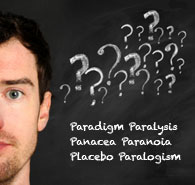 The field of neurofeedback has found itself subject to conflicting forces over the past decades, and it may be helpful to articulate some of the key factors that are driving our evolution as a discipline. On the one hand, we are subject to the constraints of a health care practitioner guild, and on the other we find ourselves in the much more uncertain terrain of frontier science. The demands of both are in essential conflict. The practitioner guild must represent to the world that a coherent system of practice exists, one grounded hopefully on a coherent model that is subscribed to by all of the practitioners. Guidelines and standards of practice likely follow to clarify for practitioners the choices that have been made for the sake of a credibly defensible public posture. The field of neurofeedback has found itself subject to conflicting forces over the past decades, and it may be helpful to articulate some of the key factors that are driving our evolution as a discipline. On the one hand, we are subject to the constraints of a health care practitioner guild, and on the other we find ourselves in the much more uncertain terrain of frontier science. The demands of both are in essential conflict. The practitioner guild must represent to the world that a coherent system of practice exists, one grounded hopefully on a coherent model that is subscribed to by all of the practitioners. Guidelines and standards of practice likely follow to clarify for practitioners the choices that have been made for the sake of a credibly defensible public posture.
On the other side we have the practical realities of frontier science, acknowledging that we are just beginning to understand the very powerful tool that we have at our disposal. The original hope (which I shared at the outset) was that a simple set of protocols derived from the original Sterman/Lubar research would serve our collective purposes. These simply needed to be pushed forward into general practice, while being subject merely to some subtle refinements. Our original NeuroCybernetics system was designed with very little flexibility because we did not see a need for it. This simple world view has had to be jettisoned.
(more…)
Posted in Application of Neurofeedback, Biofeedback, Clinical Methods, Neurofeedback, Professional Issues | 8 Comments »
Monday, June 20th, 2011
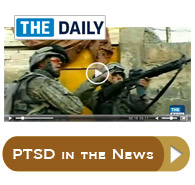 Today the web-based newspaper The Daily published a front-page article on Infra-Low Frequency Neurofeedback in application to PTSD. Along with the article there is also a six-minute video that illustrates the training procedure and basic approach. Reporter Katie Drummond did her homework on this topic over a number of months, finally coming out to our office from New York and showing up at our office with a video crew in order to try the training herself and to get acquainted with the principals. Today the web-based newspaper The Daily published a front-page article on Infra-Low Frequency Neurofeedback in application to PTSD. Along with the article there is also a six-minute video that illustrates the training procedure and basic approach. Reporter Katie Drummond did her homework on this topic over a number of months, finally coming out to our office from New York and showing up at our office with a video crew in order to try the training herself and to get acquainted with the principals.
(more…)
Posted in Application of Neurofeedback, Biofeedback, Commentary, Neurofeedback, Professional Issues, PTSD, Veterans, Video | No Comments »
Friday, April 8th, 2011
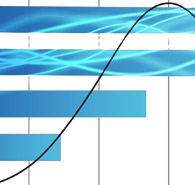 Neurofeedback is a highly promising emerging therapy for the autism spectrum. At issue here is a tool for the direct training of brain function, one that has already shown itself highly effective in addressing a wide range of “mental health” concerns. As has been the case for other therapies, its application to the autism spectrum has been complicated by the inherent complexity of the condition we confront. In the following, we recapitulate the development of neurofeedback for the autism spectrum and give some guidance to both therapists and parents with regard to the choices open to them. Neurofeedback is a highly promising emerging therapy for the autism spectrum. At issue here is a tool for the direct training of brain function, one that has already shown itself highly effective in addressing a wide range of “mental health” concerns. As has been the case for other therapies, its application to the autism spectrum has been complicated by the inherent complexity of the condition we confront. In the following, we recapitulate the development of neurofeedback for the autism spectrum and give some guidance to both therapists and parents with regard to the choices open to them.
Our own work with the autism spectrum using neurofeedback goes back some twenty-five years. In those early days of the field, the principal application of neurofeedback was to Attention-Deficit Hyperactivity Disorder (ADHD), but the very same procedures were clearly also helpful for a variety of other issues. So it came naturally to want to try these methods also with children on the autism spectrum. These early attempts were just as likely to make things worse as they were to make things better, so we quickly placed a virtual fence around autism and decided we did not know enough to venture there. Some years later, a few practitioners in our network reported some good results with newer techniques, so the door was once again opened to working with the autism spectrum.
(more…)
Posted in Application of Neurofeedback, Biofeedback, Disregulation, Neurofeedback | 5 Comments »
|
|
Subscribe to Email Newsletter
The EEG Info Newsletter circulates via email at least once a month. A variety of topics related to the Neurofeedback / EEG Biofeedback field are covered in over 200 articles.
|




 The field of neurofeedback has found itself subject to conflicting forces over the past decades, and it may be helpful to articulate some of the key factors that are driving our evolution as a discipline. On the one hand, we are subject to the constraints of a health care practitioner guild, and on the other we find ourselves in the much more uncertain terrain of frontier science. The demands of both are in essential conflict. The practitioner guild must represent to the world that a coherent system of practice exists, one grounded hopefully on a coherent model that is subscribed to by all of the practitioners. Guidelines and standards of practice likely follow to clarify for practitioners the choices that have been made for the sake of a credibly defensible public posture.
The field of neurofeedback has found itself subject to conflicting forces over the past decades, and it may be helpful to articulate some of the key factors that are driving our evolution as a discipline. On the one hand, we are subject to the constraints of a health care practitioner guild, and on the other we find ourselves in the much more uncertain terrain of frontier science. The demands of both are in essential conflict. The practitioner guild must represent to the world that a coherent system of practice exists, one grounded hopefully on a coherent model that is subscribed to by all of the practitioners. Guidelines and standards of practice likely follow to clarify for practitioners the choices that have been made for the sake of a credibly defensible public posture. Neurofeedback is a highly promising emerging therapy for the autism spectrum. At issue here is a tool for the direct training of brain function, one that has already shown itself highly effective in addressing a wide range of “mental health” concerns. As has been the case for other therapies, its application to the autism spectrum has been complicated by the inherent complexity of the condition we confront. In the following, we recapitulate the development of neurofeedback for the autism spectrum and give some guidance to both therapists and parents with regard to the choices open to them.
Neurofeedback is a highly promising emerging therapy for the autism spectrum. At issue here is a tool for the direct training of brain function, one that has already shown itself highly effective in addressing a wide range of “mental health” concerns. As has been the case for other therapies, its application to the autism spectrum has been complicated by the inherent complexity of the condition we confront. In the following, we recapitulate the development of neurofeedback for the autism spectrum and give some guidance to both therapists and parents with regard to the choices open to them.
Breaking News on PTSD & Neurofeedback
Monday, June 20th, 2011(more…)
Posted in Application of Neurofeedback, Biofeedback, Commentary, Neurofeedback, Professional Issues, PTSD, Veterans, Video | No Comments »